As I write, we are having a brief ’breather’ between lambings here in Northants. The sheep, in common with the rest of the natural world, have no concept of the chaos that is going on around us, and lambing progresses regardless of viruses and lockdowns.
We are incredibly fortunate to have a secure barn for the sheep to lamb in, safe from inclement weather and hungry foxes. It is also fortunately near to my home, so I have been able to keep travel to a minimum. That said, the weather has been very kind, with the bulk of the flock lambing during the fine spell of weather in the latter half of March, and the new lambs able to go out onto some fresh spring grass in warm sunshine. Watching them play along the hedgerows, whilst listening to curlew, lapwing and skylarks, is the most wonderful feelgood factor in these challenging days.
And yes, the days are long! I start my lambing shift at 4am, working through the day until the final feeding time for the ewes at around 6.30pm, and reserve manager Jane Pearman takes the evening shift, staying with the sheep until things tend to go quiet around midnight. At night we are sometimes joined in the barn by the semi-resident barn owl and a pair of kestrels.



